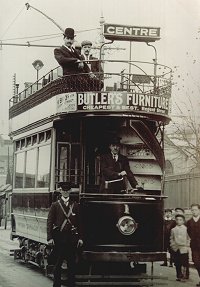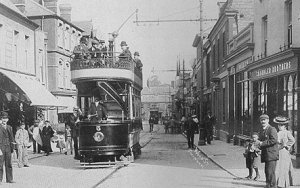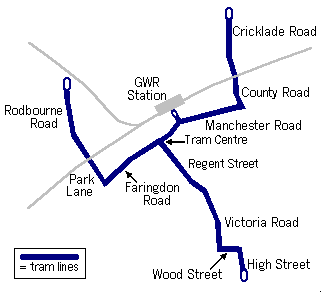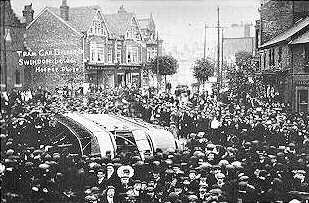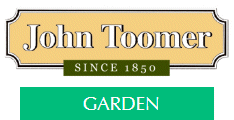The Age of the Tram
Remembering the days when trams travelled the streets of Swindon
The age of the tram in Swindon was a brief but colourful chapter in the history of the town which included an early tragedy, a period of great success and finally a surrender to the more effective - though much less picturesque - method of public transport, the bus.
A steam tramway was proposed in Swindon as early as 1883, but not until November 1899 were plans finally approved for the opening of a small network. After years of talking about setting up a tram system in Swindon, the question had been brought to a head by three main factors. The two separate boroughs of Old and New Swindon were about to be amalgamated into a new corporation and there was a growing need to head off interest from outside parties who had already realized the viability of trams in the town. But perhaps most of all it made economic sense to develop the tram system in tandem with the spread of the new electricity network which was about to revolutionise life in Swindon.
WATCH VIDEO
The History of Swindon Trams
The Age of Tram contd...
There was to be just over three and a half miles of track - with a fifth of it doubled so that trams travelling in opposite directions could run side by side. The tramcars would run over a track with a gauge of just 3ft 6ins. This was the narrowest gauge of tram in common use at the time and was necessary because of the narrowness of parts of Regent Street through which the trams would pass. The original nine 32hp cars - which was later increased to 12 - had seating for 26 people inside and 28 on the open top deck and had staircases at each end, under which sat the driver.
The livery was cream and crimson lake and interior woodwork was varnished oak. The overhead wire were hung from taper poles with neat scroll work at the top and were painted dark green. (In 1921 a thirteenth tram was delivered with two 30hp motors and, interestingly, is only tram still to survive and is currently being restored.)
Much stronger arguments raged over whether trams should operate on Sundays and the town clerk eventually organised a poll among the people of Swindon because the corporation could not reach a decision. They voted overwhelmingly, "yes".
By the summer of 1904 work was almost complete. The focal point of the system was to be the junction of Fleet Street and Bridge Street, which soon became known as "The Tram Centre" or simply "The Centre". From here you could catch a tram to one of three destinations for a penny - the Duke of Edinburgh in Cricklade Road, Rodbourne Road School or the Market Square in Old Town and there was also a short branch to the GWR station. Special workmen's cars were laid on, originally running between 5.30am and 8am, and 5.30pm and 6.30pm, plus noon to 1pm on Saturdays. On these runs, special covers were fitted to the seats to protect them from the workers' dirty clothes.
It left the GWR station, where a hundred guests of the mayor, Alderman J Hinton had enjoyed a celebratory luncheon, and ran into trouble when it rounded the corner at The Centre. The driver had taken the corner too fast and dislodged the trolley head.
All the passengers were forced to dismount and board another car while the large crowd waiting at the Town Hall stood puzzled by the delay.
If the accident caused much amusement at the time, the crash of 1906 - less than two years later - was an altogether more serious matter. Large crowds had used the trams to travel to Broome Manor Farm which was hosting the Bath and West and Southern Counties Shows. On June 1 car no. 11 left Wood Street heavily laden with passengers who standing on both decks despite rain. When it started to descend the steep hill of Victoria Road it ran out of control, the driver unable to apply the brakes. Passengers panicked and some men tried to jump clear. One was caught by his coat and badly injured as he was dragged after the now speeding car. But he was perhaps one of the lucky ones.
Alfred Manners, the manager of the Queen's Theatre, recalled: "The car came over with a terrific crash and the passengers were all more or less badly hurt - some, in their bewilderment, doing themselves serious injury amongst broken glass. The cries were awful."
Four people died immediately and a fifth some weeks later. Thirty people were injured.
Later investigation showed that brake failure had caused the accident and that overloading had not been a factor. The car was eventually repaired by GWR workmen and returned to service. Though the accident affected public confidence in trams at first, they were to become a popular and widely used service.
By 1914 they were carrying an average of 7,000 passengers a day and continued to be used extensively during the First World War, when female conductors were allowed for the first time. They were employed on the strict understanding that it was for the duration only.
The success of trams continued into the 1920s, but it was clear that their days were numbered. Because of the narrowness of some of the streets, trams proved too cumbersome amongst the increasing road traffic and in February 1928 the borough surveyor reported that the track was nearing the end of its life. Before the year was out a fleet of Leyland double-decker buses had been ordered and the trams' fate was sealed. The last tram travelled along the Gorse Hill to Rodbourne route on July 11, 1929 - driven, appropriately, by George Cathcart, one of the original motormen. The reign of trams in Swindon had lasted less than 25 years. |
|
||||||||
|
Terminus Cafe |
||||||||
|
||||||||
|
||||||||
|
||||||||
|
||||||||
|
||||||||
|
||||||||
|
||||||||
|
||||||||
|
||||||||
|
||||||||
|
||||||||
|
||||||||
| Swindon History - more articles | ||||||||
|
|||||||||





